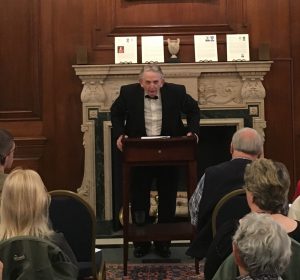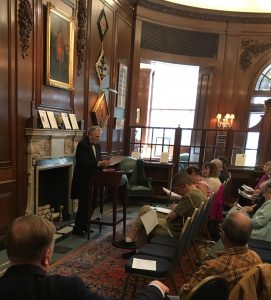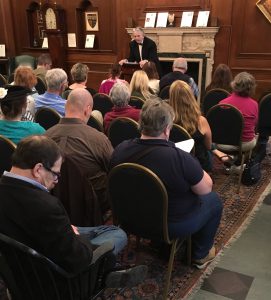 The Society’s Treat Rotunda was the setting Saturday for Gary Boyd Roberts’s seminar marking the publication of his new book, The Royal Descents of 900 Immigrants to the American Colonies, Québec, or the United States. More than thirty participants thronged the room to hear Gary’s reflections on new scholarship on Americans of royal descent; for the first time in the series, this volume also includes information on the royal lines of French-Canadians. The day concluded with a round table session featuring some of the scholars with whom Gary has collaborated in amassing his growing collection of notable Americans of royal descent.
The Society’s Treat Rotunda was the setting Saturday for Gary Boyd Roberts’s seminar marking the publication of his new book, The Royal Descents of 900 Immigrants to the American Colonies, Québec, or the United States. More than thirty participants thronged the room to hear Gary’s reflections on new scholarship on Americans of royal descent; for the first time in the series, this volume also includes information on the royal lines of French-Canadians. The day concluded with a round table session featuring some of the scholars with whom Gary has collaborated in amassing his growing collection of notable Americans of royal descent.
Among those in attendance at the event, many of them coming from a distance, were Thomas Allaire, Philip Vanderbilt Brady (of South Carolina), Richard Brenneman, David and Rene Dearborn, John Blythe Dobson (of Winnipeg), John P. Hickey Jr. (of Milwaukee), Margaret Foxe Mill, Julie Helen Otto, Douglas Richardson (of Salt Lake City), and Don Charles Stone.
 Gary’s first lecture covered the sometimes surprising connections between international historical figures and Americans of today, from Jane Austen to the 1st Duke of Wellington, Lucrezia Borgia to Count Zinzendorf, and Tycho Brahe to Elihu Yale. (Gary laid some emphasis on his “glorious mispronunciation” of certain exotic foreign names.)
Gary’s first lecture covered the sometimes surprising connections between international historical figures and Americans of today, from Jane Austen to the 1st Duke of Wellington, Lucrezia Borgia to Count Zinzendorf, and Tycho Brahe to Elihu Yale. (Gary laid some emphasis on his “glorious mispronunciation” of certain exotic foreign names.)
He noted the hundreds of colonial-era immigrants of royal descent to America whose descendants now number in the millions. While today distinguished immigrants may sojourn in America for a year or two, as scholars at a university or while appearing in a play on Broadway, the bulk of his subjects arrived in America as immigrants and remained here for the rest of their lives. Whether as younger sons and daughters of still-prominent families in Europe, or at some remove from an earlier monarch or noble, these genealogically-interesting immigrants have gone on to produce distinguished progeny, weaving together disparate strands between the Old World and the New.
 This edition of Roberts’s Royal Descents is in two volumes. Its format will be familiar to readers of the series, the first edition of which was published in 1993; with each update, and each revised volume, the list of connections grows. As ever, the official scope of the work (900 immigrants, in this case) undercounts the number covered: it is actually 970. The book suggests, as Gary notes, “much about distant kinships of living Americans, the total contributions to American life of persons of noble, royal, and gentle ancestry, and genealogical connections between Americans and many major leaders in world history.”
This edition of Roberts’s Royal Descents is in two volumes. Its format will be familiar to readers of the series, the first edition of which was published in 1993; with each update, and each revised volume, the list of connections grows. As ever, the official scope of the work (900 immigrants, in this case) undercounts the number covered: it is actually 970. The book suggests, as Gary notes, “much about distant kinships of living Americans, the total contributions to American life of persons of noble, royal, and gentle ancestry, and genealogical connections between Americans and many major leaders in world history.”
Since I have RD600 (2 volumes), it would be nice if the NEW data was presented to the public in an index format. Maybe just a list of WHO is being added ?
Other than professional researchers (who can claim a tax break) and libraries, the price alone for RD900 puts it beyond the reach of most serious amateurs.
Very interesting. This summer, I led discussion groups on three English queens as presented in historical fiction, in a Fact v. Fiction format. Among my dozen or so participants we had descendants, not of royalty, but of DeSpencers and DeBohuns, and two other Magna Carta descendants. Amazing how far afield they can wander.
So grateful to Mr. Roberts for all he has done and continues to do do all of us. What a an unparalleled scholar – and a man with a huge heart!